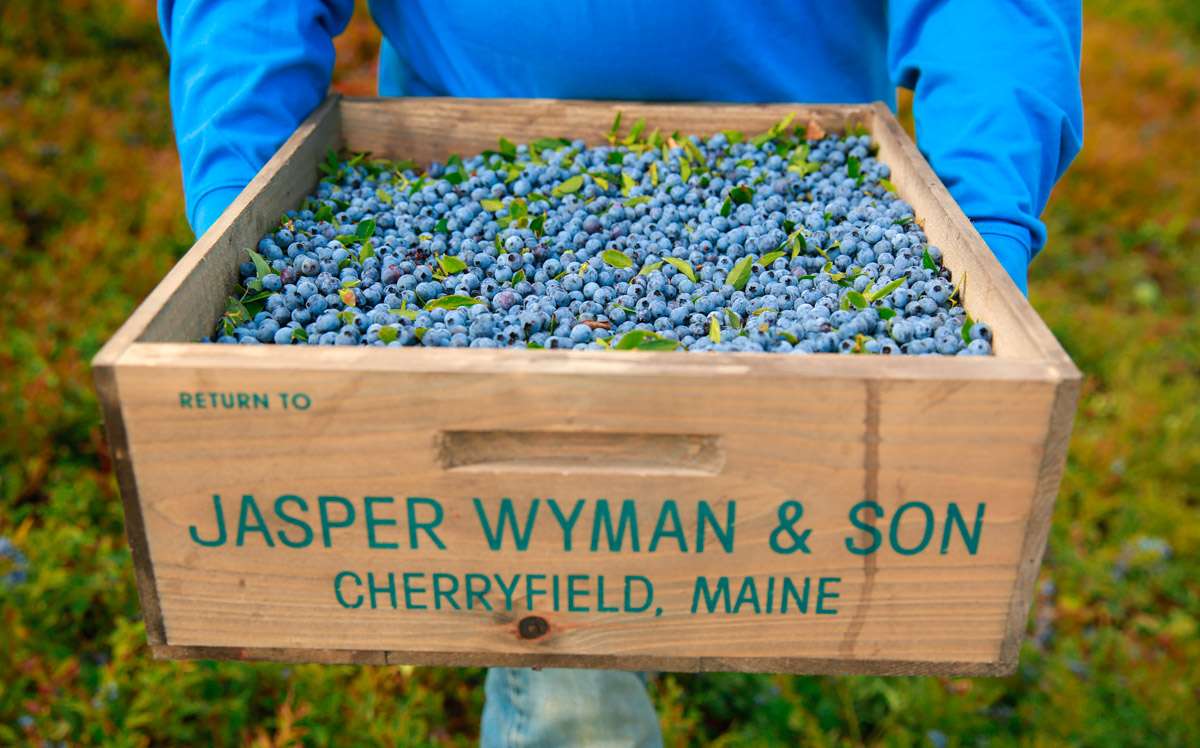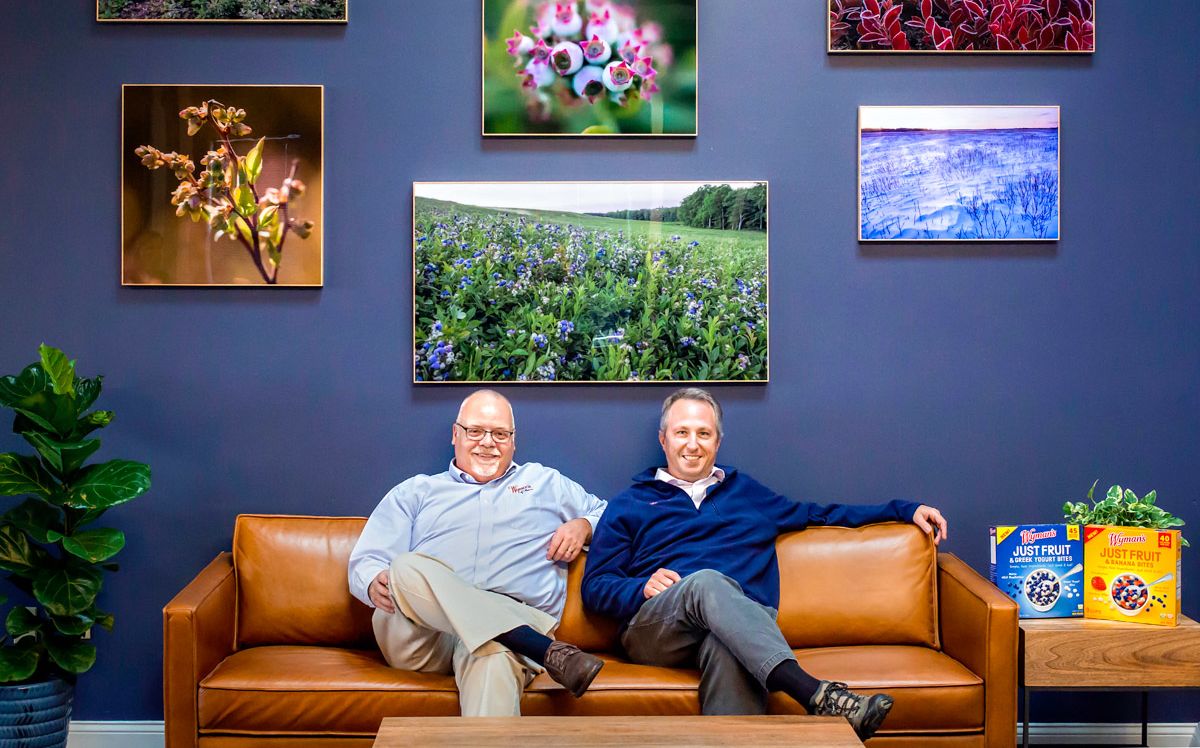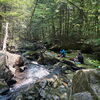
Processing Your Payment
Please do not leave this page until complete. This can take a few moments.
- News
-
Editions
View Digital Editions
Biweekly Issues
- December 1, 2025
- Nov. 17, 2025
- November 03, 2025
- October 20, 2025
- October 6, 2025
- September 22, 2025
- + More
Special Editions
- Lists
- Viewpoints
-
Our Events
Event Info
Award Honorees
- Calendar
- Biz Marketplace
Born to be wild: New products and promotion get Maine wild blueberry industry back on track
 Photo / Tim Greenway
Patrick Carroll, left, vice president of marketing, and Tony Shurman, president and CEO of Jasper Wyman & Son, at the Milbridge-based frozen-fruit company’s Portland office. Wyman’s recently launched a line of Just Fruit ready-to-eat frozen snacks expected to have a national footprint within the next 12 months.
Photo / Tim Greenway
Patrick Carroll, left, vice president of marketing, and Tony Shurman, president and CEO of Jasper Wyman & Son, at the Milbridge-based frozen-fruit company’s Portland office. Wyman’s recently launched a line of Just Fruit ready-to-eat frozen snacks expected to have a national footprint within the next 12 months.
“Gently squeeze, shake or tap to loosen contents,” read the package instructions on the serving-size cup of Just Fruit & Greek Yogurt Bites, a new ready-to-eat frozen snack made with Maine wild blueberries under the Wyman’s label.
Jasper Wyman & Son, the Milbridge-based fruit processor that has been led by President and CEO Tony Shurman since 2017, is trying to do the same — sell more wild blueberries and shake things up in an industry struggling to make a comeback after years of overproduction and low prices.
“We don’t care whether you’re introduced to Wyman’s through the innovation or get introduced through the bagged fruit, so long as you get introduced,” Shurman says in the firm’s Portland office on West Commercial Street. “What we’ve come up with is a very convenient way to just reach into the freezer, and you can eat it right like that. That’s this ‘Aha!'”

The new Just Fruit line of frozen fruit and yogurt bites is being rolled out in the Northeast and beyond, starting with BJ’s, Hannaford, Market Basket Big Y and Harris Teeter. That brings Wyman’s into a new category described as “healthy convenience” by Patrick Carroll, vice president of marketing, who expects a national footprint within the next 12 months.
Carroll says the firm has a dozen other items in development, though only has the resources to do one a year, and isn’t too worried about copycat rivals because “we beat them to the punch.”
As the only large Maine wild blueberry supplier with a retail brand, Wyman’s innovation moves are being closely watched by others in the industry — and adding to expectations of a gradual sector rebound.

An industry in flux
Wild blueberries grow only in Maine and Atlantic Canada. Maine’s 40,000 acres of
fruit grow along the Downeast coast to the state’s southwest corner, going back 10,000 years though they weren’t commercially harvested until the 1840s.
Maine is the country’s sole commercial producer of wild or lowbush blueberries, which are smaller and less ubiquitous than cultivated or highbush varieties. Thought they’re available fresh in season, they are primarily sold in frozen form.
Today’s market is highly fragmented, with 60% of production controlled by a handful of players. Besides Wyman’s, they include Cherryfield Foods Inc., owned by Canada’s Oxford Frozen Foods; Allen’s Blueberry Freezer and Merrill Blueberry Farms Inc., both in Ellsworth; and Allen’s Wild, of Orland. Together, the five also own about half the land where wild blueberries are grown.
The largest grower who isn’t also a processor is the Passamaquoddy Tribe, with about 2,000 acres, while 480 farms make up the rest. Most are under 50 acres, though falling prices have forced some smaller operations out of business.
Despite being a hearty crop suited to harsh Maine winters, wild blueberries are affected by weather and climate change. In recent years, the biggest disruption was an oversupply of a few years ago, prompted by the growth of the cultivated crop and more cultivated berries being frozen, and three large wild blueberry crops in a row in both Maine and Canada.
In Maine, more than 100 million pounds of wild berries were harvested in 2014, 2015 and 2016 — the highest annual output in the last decade. In 2017, prices paid to farmers fell as low as 25 cents a pound.

Recent data show signs the situation is starting to normalize, with annual production levels moving down to 67.7 million pounds harvested in 2017 and 50.3 million pounds of berries in 2018. Prices are also starting to move higher, with the average amount paid up to 46 cents a pound in 2018.
‘The only thing we grow’
That’s some comfort to long-time growers like Ed Hennessey, board chairman and retired president of Machias Savings Bank. He and his sons farm around 400 acres of wild blueberries in Whitneyville, some of which his younger son supplies to Cherryfield Foods under contract.
Hennessey predicts a close to average crop in Maine this year, and better prices than last year. He also underscores that while the family has diversified into other business activities, they have no immediate plans to stop farming blueberries or do what his grandfather did and sell their land.
“We’re in it for the long haul,” he says. “We’ve got a lot invested, and hopefully the blueberry business will turn for the good. That’s the only thing we grow.”
Molly Sholes, owner of Spruce Mountain Blueberries in West Rockport, is less optimistic, saying, “The blueberry industry is suffering for various reasons and not making very much money.” She harvests wild blueberries from 110 hilly acres she sells fresh and uses to make chutney, jams, vinegar and toppings. Sholes, who turns 89 this month, lost one of her biggest customers when the State of Maine Cheese Co. owner closed the Rockport Marketplace this summer, and doesn’t see herself in the business much longer.
‘Time for the good times’
Looking at the bigger industry picture, David Yarborough, interim executive director of the Wild Blueberry Commission of Maine, sees cause for optimism.
“Agriculture goes in cycles,” he notes. “We’ve had good times and we’ve had bad times. It’s now time for the good times.” At the same time, he sees the industry’s biggest challenge as maintaining production at profitable levels and differentiating wild blueberries in consumers’ eyes from cultivated ones.
“We’re a very small crop with very small companies, but there are outlets for product and market diversification,” he says. That includes Wyman’s, which despite a limited budget has “done an excellent job with the marketing.”
Cherryfield Foods, which doesn’t have its own brand but sells to grocery stores for private-label use, has focused its innovation efforts mainly on packaging as well as on growing a better fruit, according to general manager David Bell, saying, “We’re always trying to improve quality and lower defects.”
Working with the Ethos agency in Westbrook since 2013, the Wild Blueberry Association of North America uses targeted and social media “influencer” marketing to expand markets for blueberries, for example in schools. There’s even a website (www.wildblueberries.com) with recipes and health information.
Ethos account strategist Mike Collins says the strategy has never been to degrade cultivated blueberries, but to show the health and taste advantages of the wild variety where you “get more flavor in every bite.”
Uncorking new opportunities
Wyman’s isn’t the only wild blueberry product innovator.
In Scarborough, entrepreneurs Michael Terrien and Eric Martin are making sparkling wine from wild Maine blueberries. Five years after launching in Jefferson, they’re up to 180 wholesale accounts across several states and working with Gray Harris at Coastal Enterprises Inc. to expand in what Terrien expects to be a $100 million market in 20 years.

“There’s no higher value-added than wine for a fruit,” Terrien says.
Back at Wyman’s, Shurman and Carroll say they’re open to the idea of a Wyman’s smoothie product or co-promotions with almond- milk makers.
“We’re going to have to take our time and be really smart about the investment choices that we make,” Shurman says, “and virtually all of them will include wild blueberry as the hero within.”
Mainebiz web partners

The Giving Guide
The Giving Guide helps nonprofits have the opportunity to showcase and differentiate their organizations so that businesses better understand how they can contribute to a nonprofit’s mission and work.
Learn More
Work for ME
Work for ME is a workforce development tool to help Maine’s employers target Maine’s emerging workforce. Work for ME highlights each industry, its impact on Maine’s economy, the jobs available to entry-level workers, the training and education needed to get a career started.
Learn More
Groundbreaking Maine
Whether you’re a developer, financer, architect, or industry enthusiast, Groundbreaking Maine is crafted to be your go-to source for valuable insights in Maine’s real estate and construction community.
Learn more-
The Giving Guide
The Giving Guide helps nonprofits have the opportunity to showcase and differentiate their organizations so that businesses better understand how they can contribute to a nonprofit’s mission and work.
-
Work for ME
Work for ME is a workforce development tool to help Maine’s employers target Maine’s emerging workforce. Work for ME highlights each industry, its impact on Maine’s economy, the jobs available to entry-level workers, the training and education needed to get a career started.
-
Groundbreaking Maine
Whether you’re a developer, financer, architect, or industry enthusiast, Groundbreaking Maine is crafted to be your go-to source for valuable insights in Maine’s real estate and construction community.
ABOUT
NEW ENGLAND BUSINESS MEDIA SITES
No articles left
Get access now
In order to use this feature, we need some information from you. You can also login or register for a free account.
By clicking submit you are agreeing to our cookie usage and Privacy Policy
Already have an account? Login
Already have an account? Login
Want to create an account? Register
Get access now
In order to use this feature, we need some information from you. You can also login or register for a free account.
By clicking submit you are agreeing to our cookie usage and Privacy Policy
Already have an account? Login
Already have an account? Login
Want to create an account? Register







0 Comments